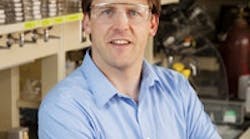An ionic liquid catalyst significantly cuts the energy requirements for electrochemically reducing carbon dioxide to carbon monoxide, say researchers at the University of Illinois at Urbana-Champaign, and a startup company, Dioxide Materials, Champaign, Ill. The CO then can serve as a feedstock for producing simple fuels like formic acid and methanol, which in turn can be used for making ethanol and other fuels, they add.
"[The ionic liquid — 1-ethyl-3-methylimidazolium tetrafluoroborate] lowers the overpotential for CO2 reduction tremendously," notes Paul Kenis, a professor of chemical and biological engineering at the school (Figure 1). "Applying a much lower potential corresponds to consuming less energy to drive the process."
The researchers observed gas-phase CO formation at an applied voltage of 1.5 volts, which equates to an overpotential of only 0.17 V. Under identical conditions, but without the ionic liquid, cell potential must reach 2.1 V before CO is detected.
Gas chromatography shows that only three products form in the flow cell — hydrogen and CO on the silver cathode and oxygen on the platinum anode. Faradaic efficiency (i.e., the amount of electrons going to the CO product versus the hydrogen byproduct) always exceeded 96%. The energy efficiency is 87% at 1.5 V. More details appear in a recent article in Science.
Electrochemically reducing CO2 to make fuels offers a number of benefits over biomass conversion. "The key advantage is that there is no competition with the food supply," notes Richard Masel, CEO of Dioxide Materials and a retired chemical engineering professor at the school. "And it is a lot cheaper to transmit electricity than it is to ship biomass to a refinery," he adds. In addition, the approach provides an outlet for CO2 recovered by emission-reduction processes.
Efforts are underway to improve throughput. Turnover now runs 1/sec or less. It certainly will be possible to match the 10/sec of chlor-alkali cells, says Kenis. "We probably can go a factor or two to six beyond that."
Improving electrode durability will take some effort, he adds.
The ionic liquids themselves are expensive but they are very stable and can be reused, notes Kenis. There's no loss by evaporation.
Dioxide Materials is tackling scale-up issues.
